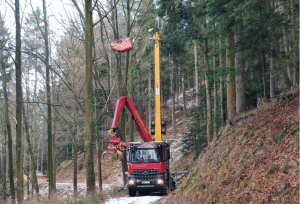Increase in profit margins anticipated with energy-recuperating, slack-pulling carriages in cable-yarding
In the first study of its kind, TECH4EFFECT authors from BOKU and CNR reveal in a paper published in the International Journal of Forestry Engineering that energy-recuperating slack-pulling carriages have the potential to improve profit margins in small-tree operations through lower fuel consumption.

Energy-recuperation technology has been introduced to carriages by several cable yarding equipment manufacturers, like Konrad, over the last years. The fieldwork for this study was undertaken using the Konrad Forsttechnik GmbH ELINER 5000 carriage which was employed on a Konrad Forsttechnik GmbH MOUNTY 4000 truck-mounted tower yarder in an uphill whole-tree yarding operation. The work was undertaken by harvesting contractor Forstunternehmen Hirtler. Photo courtesy of Thomas Varch.
Cable yarding technology cost-intensive
Cable yarding technology has been used for over a century to extract wood from impassable terrain via a suspended cable that carries logs from the forest to the roadside. While it can be used in both flat and steep areas, it is associated more with timber extraction from mountainous terrain where, according to the paper’s abstract, it is the “primary extraction technology, which is usually deployed on difficult sites”.
According to Spinelli et al. 2015, since the complexity of a yarding system requires a large investment to achieve a lower production target, cable yarding is an inherently expensive technology.
Fuel cost constitutes an important component of total harvesting cost and, along with labour and capital costs, it ranks among the entrepreneur’s top concerns (Spinelli et al. 2017a, Harrill et al. 2019).
Silvicultural treatments postponed due financial viability
In fact, low productivity can lead to postponement of treatments urgently required from a silvicultural viewpoint to increase their financial sustainability. For example, about one third of the protection forests in Austria are in urgent need of tending and regeneration, but their active management has become increasingly unprofitable due to stagnating timber prices (BMLRT 2020).
The focus of the paper published in the International Journal of Forest Engineering titled “Productivity, fuel consumption and cost in whole tree cable yarding: conventional diesel carriage versus electrical energy-recuperating carriage” studied whether the energy-recuperating carriages could increase the financial viability of cable yarding operations by reducing fuel consumption, and thus the total cost of the operation.
Energy-recuperation carriages show promise
TECH4EFFECT Work Package Leader of Harvesting and BOKU Forest Engineer, Department of Forests and Soil Sciences, Dipl.-Eng. Dr. Gernot Erber, said that energy recuperation technology had been introduced to carriages by several cable yarding equipment manufacturers over the last years with the primary goal to decrease fuel consumption and, thereby, reduce the total cost of an operation. He added that the present study constituted the first to investigate the effect of energy recuperation technology on cable yarding operations.
In the present study, productivity, fuel consumption and cost of whole tree cable yarding with a novel energy-recuperating, slack-pulling carriage (Konrad Forsttechnik GmbH ELINER 5000) and a conventional, diesel engine-powered slack-pulling carriage (Konrad Forsttechnik GmbH LIFTLINER 4000) were compared.
The ELINER 5000 recuperates energy during lateral yarding – the process of pulling the load towards the cable corridor – and stores it as electrical energy in super-capacitors for powering “slack-pulling” – the process of spooling out the line to which the load is attached – during the subsequent yarding cycle. The purpose of slack-pulling is to facilitate the work of the person attaching the load by relieving them from the exhausting task of having to pull out this line manually.
While productivity did not differ between carriage types, fuel consumption and cost did. However, the positive effect of the energy-recuperating carriage on fuel consumption was limited by a break-even average tree volume and to shorter yarding distances.
“In conclusion, the energy-recuperating, slack-pulling carriage has the potential to improve profit margins in small-tree operations through lower fuel consumption, especially over short yarding distances,” Erber explained.
The fieldwork for this paper was carried out in Austria in association with the TECH4EFFECT partners BOKU, Konrad Forsttechnik GmbH and CNR, supported by the harvesting contractor Forstunternehmen Hirtler.
International Journal of Forest Engineering
The results were published in the International Journal of Forest Engineering with the article titled “Productivity, fuel consumption and cost in whole tree cable yarding: conventional diesel carriage versus electrical energy-recuperating carriage”. This paper will be part of the TECH4EFFECT International Journal of Forest Engineering Special Issue which is due to be featured in 2021. The open access publication is available HERE.
Authors: Thomas, Varch; Gernot Erber; Raffaele Spinelli; Natascia Magagnotti & Karl Stampfer.
This project has received funding from the Bio Based Industries Joint Undertaking under the European Union’s Horizon 2020 research and innovation programme under grant agreement No 720757.


